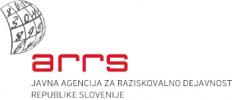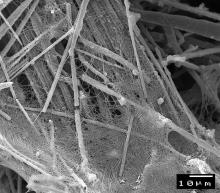Biogenicity of fibrous microcrystalline calcite in vadose terrestrial settings
Principal Investigator at ZRC SAZU
Andrea Martín Pérez, PhD-
Original Title
Biogenost vlaknatih mikrokristalnih oblik kalcita v vadoznih terestričnih okoljih
-
Project ID
Z1-7247
-
Duration
1 January 2016–31 December 2017 -
SICRIS
Z1-7247 -
Financial Source
Javna agencija za raziskovalno dejavnost Republike Slovenije

Fibrous microcrystalline calcite (FMC) is one of the most common and widespread forms of secondary calcium carbonate in vadose terrestrial environments (caves, soils, surficial sediments, etc.). FMC is characterized by two basic habits: needle fiber calcite (NFC) and nanofibers, both varieties composed of low-Mg calcite. The origin of FMC crystals has generally been attributed either to purely physicochemical processes or to microbial biomineralization. The current biogenic hypotheses are largely based on common co-occurrence of fibrous calcite and microbial features, and the similarity in dimensions and morphology of calcite fibers with fungal hyphae and filamentous bacteria. Morphological arguments for biogenicity have been supported by geochemical and petrographic data, considered as biosignatures preserved in certain forms of FMC.
There is a considerable evidence that deposits of FMC make specific microbial ecosystems in the vadose zone, i.e., many studies have shown positive association of diverse microbial communities with fibrous calcite, what is particularly evident in soft, hydrated cave sediments known as moonmilk. However, the controversy remains regarding the role of microorganisms in carbonate mineralization.
The purpose of the proposed project is to test the hypothesis of biogenic precipitation of FMC using in-situ and laboratory investigation of calcite moonmilk from actively precipitating sites in four Slovenian karst caves. The project is primarily aimed at evaluating the mechanisms of biologically-induced vs. biologically-influenced vs. inorganic precipitation. The main objectives are: 1) to define the physicochemical parameters of the FMC precipitation microenvironments in caves through systematic, regular in-situ measuring, sampling, and analysis (optimally, through a one year period); 2) to characterize organic and inorganic chemistry of water from moonmilk deposits; 3) to extract and characterize organic polymeric substances from the moonmilk interstitial waters; 4) to examine the structure of FMC precipitating microenvironments; and 5) to undertake in-situ precipitation experiments of calcite crystallization in natural cave environment but under controlled conditions.
The proposed study sites in Slovenian caves are targeted because they include all different microenvironments of FMC precipitation. One of the caves is close to the lab and easily accessible throughout the year and will be used as a main field site for regular sampling of water and mineral precipitates, as well as for continuous microclimate determination.
The study will contribute to the understanding of fundamental principles of calcium carbonate deposition in near-surface terrestrial settings. Apart from the broad field of sedimentology, the results will bear significance for geomicrobiology and materials science.
